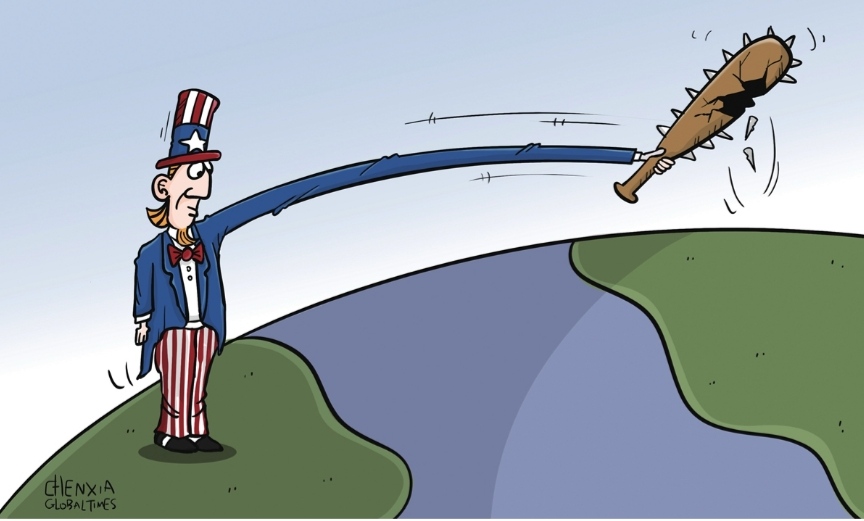In Case US Prosecutes Huawei Again, China Will Take countermeasures
Source : Global Times

Meng Wanzhou has returned to the motherland. This is a landmark event which carries significance for China’s integration with the world and the international order.
No matter how China, the US and Canada communicated and negotiated, Washington and Ottawa agreed to release her. The result shows that the US long-arm jurisdiction could be disrupted. This is China’s successful challenge to US hegemonism.
US unilateral sanctions reached their peak during the era of former president Donald Trump. Statistics from the International Law firm of Gibson, Dunn & Crutcher LLP show that the Trump administration imposed 3,900 sanctions during its four years in office. This means it waved the sanction stick about three times a day.
But it is different now.
In May 2018, Trump announced the US withdrawal from the Iran nuclear deal and planned instituting the highest level of economic sanctions against Iran. This was a sheer hegemonic act that violated UN principles.
This US decision met with objections from a number of countries including China, Russia, the UK, France and Germany. Some EU members criticized the US for adopting double-standard foreign policies. The US opposed the Arab League for the latter’s boycott of Israel, but pushed the whole globe to boycott Iran. EU members even threatened to adopt countermeasures within the framework of the World Trade Organization against the US.
Germany, France and the UK then accelerated setting up the Instrument in Support of Trade Exchanges to facilitate trade with Iran.
In March 2020, the system completed its first transaction, sending medical supplies and equipment to Iran to tackle COVID-19. The function of this system provides a long-term and sustainable solution to legitimate trade between Europe and Iran. It was during this period that the Trump administration provoked a trade war against China. It then adopted a policy to comprehensively contain China’s rise.
In April 2018, the US imposed sanctions on Chinese telecom giant ZTE Corp. After that, Washington began to step up its crackdown on Huawei.
Why Huawei? Because the rise of a country, first of all, starts from the rise of its enterprises. Huawei represents the global rise of Chinese companies and Chinese manufacturing. This collective emergence has impacted the US-led system, and has affected Western capital’s control of the global market which has lasted for about five centuries.
From Huawei’s cooperation with Iran, Washington hopes to find problems similar to that of ZTE and then impose sanctions. But to its disappointment, there is no evidence proving that Huawei violated the trade embargo. The US eventually charged Huawei with bank fraud. Its reason was that Huawei did not make it clear to its bank, HSBC, about its business dealings with Iran. This is a complete forgery created by the US side in collusion with certain people at HSBC.
Although Meng was released, the US still announced she has entered into a “deferred prosecution agreement.”
Some people worry that Washington will continue its investigation and Huawei may have to accept high fines. These people have not understood the significance of Meng’s release. What comes next will probably not be how the US will throw its punches. But how China will punch back.
If the US side decides to prosecute Huawei again, what it will encounter first will be China’s Anti-Foreign Sanctions Law.
Today, Huawei cannot be easily knocked down. In 2020, the company’s sales revenues reached 891.4 billion yuan ($136.7 billion), with a net profit of 64.6 billion yuan ($9.9 billion). This year, Huawei has ranked 44th among the Fortune Global 500 companies. And what is behind Huawei is a large group of Chinese companies on the rise and the country’s comprehensive manufacturing industry. This gives China the power to fight back against hegemony.
The latest US-China trade data is quite telling. In the first five months of 2021, China exported 1.34 trillion yuan ($207.5 billion) to the US, up 38.9 percent. Meanwhile, China’s imports from the US reached 478.3 billion yuan ($74.1 billion), up 48.5 percent. And the trade surplus with the US totaled 860.51 billion yuan ($133.3 billion), an increase of 34.1 percent. In conclusion, China’s exports to the US are much larger than imports from it.
Against the backdrop, other countries that have been suppressed by Washington’s long-arm jurisdiction will hardly be as pliant and obedient under the US hegemony as they used to be.




